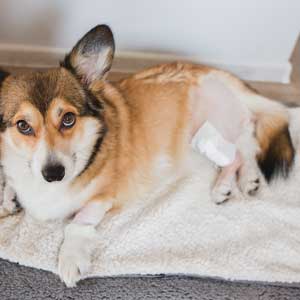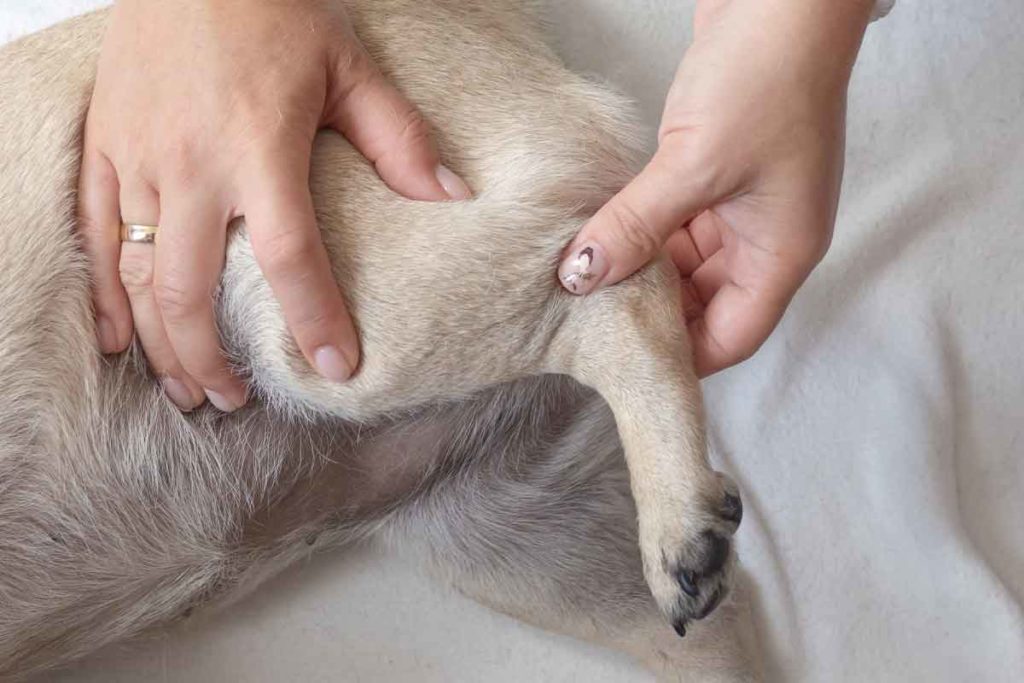A torn anterior cruciate ligament (ACL), or cranial cruciate ligament (CCL) in canines, is a very uncomfortable injury and can significantly impact your dog’s overall quality of life. A CCL rupture can occur in dogs of any age or breed and most often requires surgery. It is important for pet parents to recognize the symptoms and understand the risk factors and what to do if your dog suffers a CCL rupture.
Table of contents
- ACL vs. CCL—What’s the difference?
- Signs of a CCL tear or rupture
- How do dogs rupture their CCL?
- Risk factors of CCL injury
- Veterinarian diagnosis of a CCL injury
- Benefits of CCL surgery
- What does CCL surgery involve?
- Potential complications
- Recovery
- How can ElleVet’s CBD + CBDA support your dog’s recovery?
ACL vs. CCL—What’s the difference?
Dogs do have ACLs as people do, however the terminology in dogs is different and it is called a cranial cruciate ligament (CCL), while in humans it’s called anterior. In dogs, the CCL serves a similar function and connects the bone above a dog’s knee (the femur) to the bone below their knee (the tibia). This connective tissue is responsible for stabilizing the knee and femur from sliding backwards during a normal walking motion and over-rotating the joint.
Unfortunately, one of the most common injuries to the knee of dogs is tearing of the CCL.
Signs of a CCL tear or rupture
A CCL tear or rupture is the most common cause of lameness in the hind legs of dogs, according to veterinary experts at Colorado State University. Most dogs with this injury cannot walk normally and experience significant discomfort.
The instability caused by the tear damages allow excessive motion of the surrounding bone and cartilage in a dog’s knee. Without surgery, a dog’s body will attempt to stabilize the unstable joint with scar tissue, leading to decreased range of knee motion and excessive cartilage wear and tear. If your dog has ruptured their CCL, you may notice:
- Hind leg lameness, either limping or non-use of leg
- Difficulty or hesitation to get up from laying down, jumping, or climbing stairs
- Stiffness after getting up
- Decreased activity level and unwillingness to play
- Decreased range of motion
- Muscle atrophy in affected leg
- Popping noise or swelling
- Inability to sit squarely (kicking leg out when trying to sit)
A partial CCL tear is likely to worsen if not addressed, with the ligament progressively tearing, according to the American College of Veterinary Surgeons. Lameness may become consistent until your dog refuses to use their leg at all and nearly all CCL will eventually fully tear.
How do dogs rupture their CCL?
Though a traumatic injury is the most common reason for ACL tears in humans, VCA Animal Hospitals notes that CCL ruptures in dogs most often happen because of degeneration of the ligament.
With progressive weakening of the ligament, a dog’s CCL becomes stretched or partially torn and lameness may be only slight and intermittent. With continued use of the joint, the tear gradually gets worse until a complete rupture occurs.
Although slightly less common, trauma can also cause a CCL rupture in dogs. This most often happens when a dog twists their knee joint while running and suddenly changing direction.
Risk factors of CCL injury
While all dogs are susceptible to cruciate ruptures, some risk factors make dogs more likely to suffer this injury and undergo surgery. According to veterinary expert Debra Sellon, risk factors include:
- Genetic predisposition (large dog breeds like Newfoundlands and Labrador Retrievers)
- Overweight and obese dogs
- Other knee problems like luxating patella
- Poor fitness
- Spay/neuter status
- Age
- Previous CCL rupture increases risk of CCL rupture in other leg
Veterinarian diagnosis of a CCL injury
If you suspect your dog has suffered a ruptured CCL, it is important to consult your veterinarian as soon as possible. Your veterinarian will be able to diagnose a CCL injury with the following methods:
- Cranial Drawer Test – Your veterinarian will test to see how much the tibia bone can be moved forward in relation to the femur bone.
- Tibial Thrust Test – Your veterinarian will help your dog to mimic weight bearing to see how the front of the tibia bone is pushing forward in relation to the femur bone.
- Radiographs – In some cases, the cranial drawer test or tibial thrust is inconclusive, and radiographs of the knee will show pronounced effusion and degenerative changes that are consistent with CCL issues.
Your veterinarian will also likely examine your dog for loss of muscle mass or atrophy, swelling within a joint, or the formation of scar tissue around the knee.
Benefits of CCL surgery

Once your veterinarian has determined that your dog has ruptured their CCL, they are likely to recommend surgery. Surgery is highly effective in addressing both joint mobility and discomfort. Benefits of CCL surgery include:
- Improved joint stability
- Discomfort relief
- Improved range of motion long term
- Prevent accelerated degeneration of the joint
According to experts at MedVets, most dogs can start using their repaired leg within just days of surgery and 90-95% of dogs return to their previous activity levels. Some owners report that once their dog fully recovered, they would not know that their dog ever had an injury.
What does CCL surgery involve?
So, what does CCL surgery for dogs look like?
A tibial plateau leveling osteotomy (TPLO) is an invasive procedure aimed at reducing the amount that the tibia bone shifts forward during your dog’s stride. TPLO surgery involves making a small cut at the top of the tibia bone. The cut portion of the bone is then rotated. A plate and screws are also implanted to stabilize the bone while it heals.
Potential complications
While TPLO surgery is highly effective and is the preferred surgery by board certified veterinary surgeons, all invasive procedures involve some risks.
Your dog needs to be anesthetized during the operation, but the use of anesthesia can lead to complications. While some dogs may experience minor side effects like vomiting after anesthesia, more serious issues like cardiac arrest are possible, but very rare.
With TPLO surgery, approximately 5-10% of patients do not return the functional joint use that owners and veterinarians hoped for.
Infection occurs in less than 10% of TPLO patients but can cause serious complications. Without an e-collar, dogs can lick their incision. It is then possible for infection to move to the plate implant. While this does not typically impact bone healing, the infected plate must be removed, subjecting dogs to a second invasive procedure. It is crucial for pet parents to keep their dogs’ surgery wounds clean.
Consult your veterinarian about how to minimize the risk of these potential complications associated with TPLO surgery.
Recovery
Following CCL surgery, it is important for pet parents to understand what to expect during the recovery process. Allowing for full recovery is crucial for ensuring your dog has the best possible outcome in terms of joint mobility, comfort, and quality of life.
Veterinarians generally recommend that your dog’s movement should be restricted for about six to eight weeks following CCL surgery. This includes very short walks on leash, no jumping or running, and confinement using a crate or other small space when you’re not around to supervise.
While every dog is different, VCA Animal Hospitals indicates that the average timeline for CCL surgery is:
- About half of all canine patients will begin walking on their injured leg within 24 hours after surgery.
- After two weeks, most dogs can bear significant weight on the affected leg based on visual assessment.
- By 10 weeks, most dogs do not have a substantial limp or gait abnormality.
- At four months, the majority of dogs can begin walking and playing normally, with only the most strenuous activities restricted.
- Within six months, most dogs can resume full physical activity.
Physical rehabilitation following a CCL operation will support complete and quicker healing. Rehab can help your recovering dog build muscle strength, decrease swelling, and improve discomfort.
How can ElleVet’s CBD + CBDA support your dog’s recovery?
Limited activity and confinement may not be easy for all dogs, potentially causing stress. If you are struggling to keep your dog calm and quiet while they recover, ElleVet’s CBD + CBDA can help.
CBD + CBDA truly calms without sedating, which is key to allowing your dog to address stressful situations like being cooped up inside during recovery. ElleVet’s Calm & Comfort situational use chews act quickly to provide maximum support in stressful situations like immobilization and rest following an injury.
CBD + CBDA is also a safe and effective option for addressing joint discomfort in dogs by working to improve discomfort and reduce inflammation. CBD + CBDA helps your dog by modulating their inflammatory response and perception of discomfort. This can be particularly beneficial for dogs going through rehab following CCL surgery to allow them to more comfortably build back strength and range of motion.
As always, consult your veterinarian if your dog shows signs of joint discomfort. For any questions about ElleVet’s CBD + CBDA products or how CBD can help your canine companion have the best quality of life possible with less discomfort, give us a call (844-673-7287) or send us an email ([email protected]). We are here to help.
Any health or medical information in ElleVet blogs is from a variety of public and reputable sources. This information is intended as an educational resource only and is not a substitute for expert professional care.








